Marketing Process & Planning for Desklib Online Library
VerifiedAdded on 2023/06/04
|19
|4677
|479
AI Summary
This guide provides insights on the marketing process and planning for Desklib, an online library for study material. It covers the marketing concept, functions, and mix, along with marketing planning and extended marketing mix with examples. The guide also includes a strategic marketing plan that connects with the organizational objectives, corporate strategy, and mission.
Contribute Materials
Your contribution can guide someone’s learning journey. Share your
documents today.
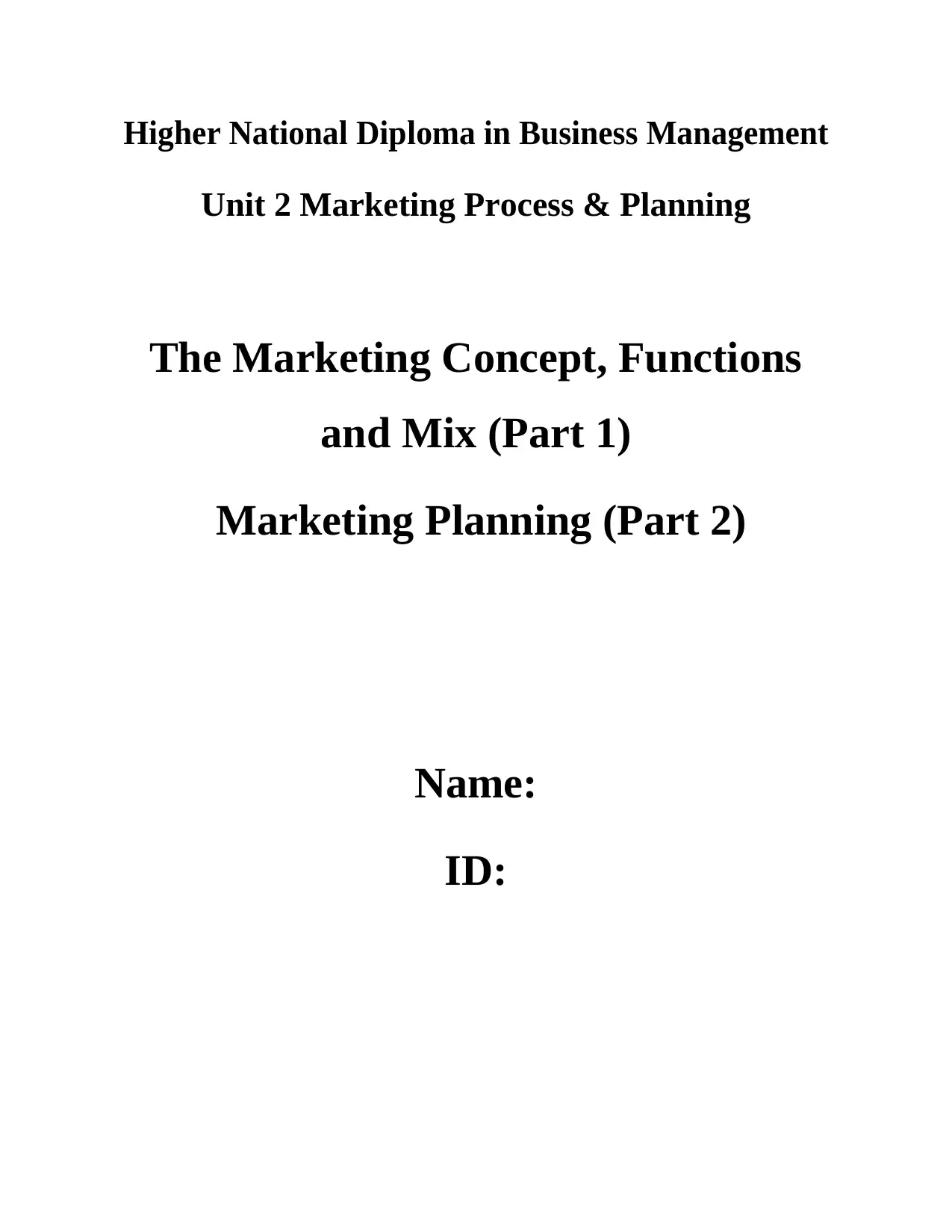
Higher National Diploma in Business Management
Unit 2 Marketing Process & Planning
The Marketing Concept, Functions
and Mix (Part 1)
Marketing Planning (Part 2)
Name:
ID:
Unit 2 Marketing Process & Planning
The Marketing Concept, Functions
and Mix (Part 1)
Marketing Planning (Part 2)
Name:
ID:
Secure Best Marks with AI Grader
Need help grading? Try our AI Grader for instant feedback on your assignments.
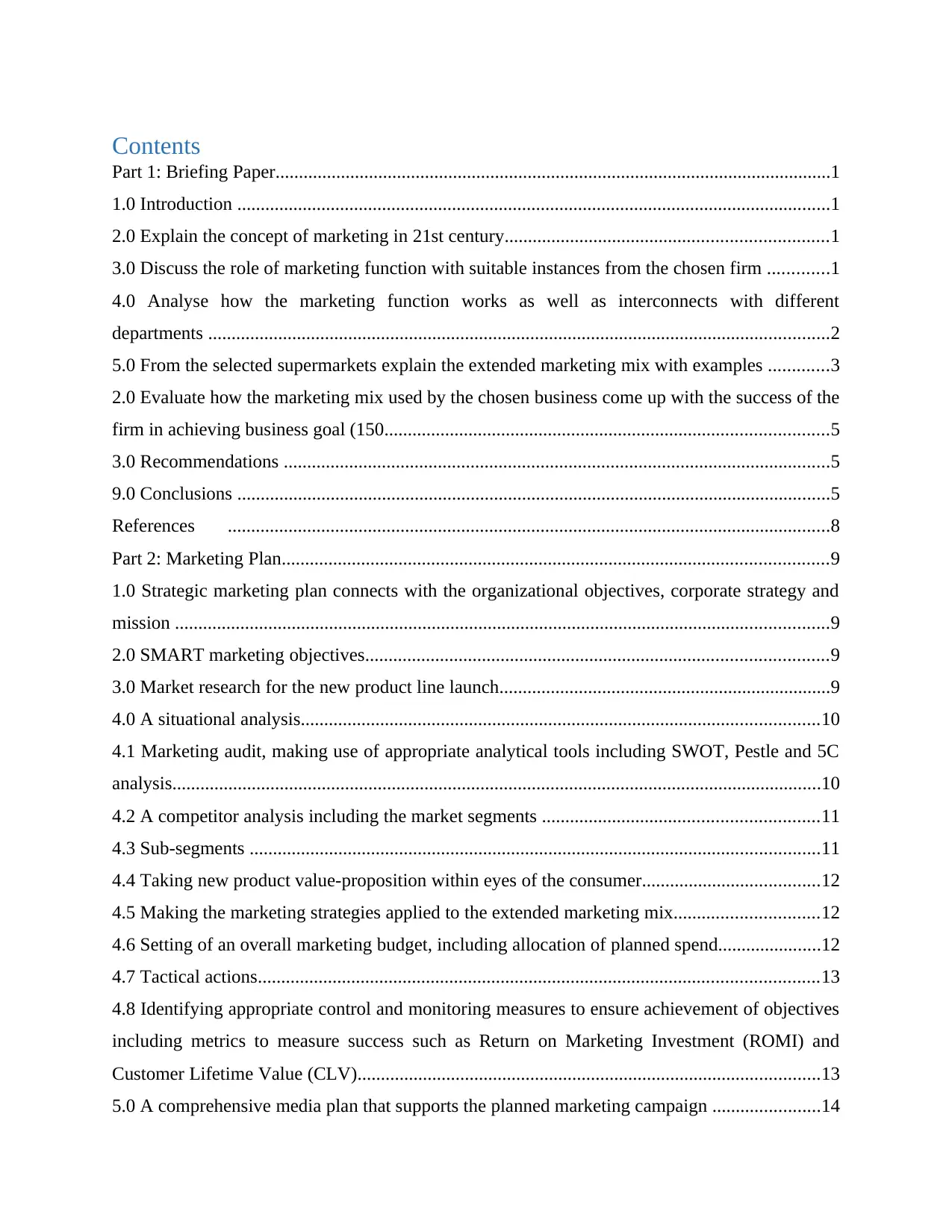
Contents
Part 1: Briefing Paper.......................................................................................................................1
1.0 Introduction ...............................................................................................................................1
2.0 Explain the concept of marketing in 21st century.....................................................................1
3.0 Discuss the role of marketing function with suitable instances from the chosen firm .............1
4.0 Analyse how the marketing function works as well as interconnects with different
departments .....................................................................................................................................2
5.0 From the selected supermarkets explain the extended marketing mix with examples .............3
2.0 Evaluate how the marketing mix used by the chosen business come up with the success of the
firm in achieving business goal (150...............................................................................................5
3.0 Recommendations .....................................................................................................................5
9.0 Conclusions ...............................................................................................................................5
References .................................................................................................................................8
Part 2: Marketing Plan.....................................................................................................................9
1.0 Strategic marketing plan connects with the organizational objectives, corporate strategy and
mission ............................................................................................................................................9
2.0 SMART marketing objectives...................................................................................................9
3.0 Market research for the new product line launch.......................................................................9
4.0 A situational analysis...............................................................................................................10
4.1 Marketing audit, making use of appropriate analytical tools including SWOT, Pestle and 5C
analysis...........................................................................................................................................10
4.2 A competitor analysis including the market segments ...........................................................11
4.3 Sub-segments ..........................................................................................................................11
4.4 Taking new product value-proposition within eyes of the consumer......................................12
4.5 Making the marketing strategies applied to the extended marketing mix...............................12
4.6 Setting of an overall marketing budget, including allocation of planned spend......................12
4.7 Tactical actions........................................................................................................................13
4.8 Identifying appropriate control and monitoring measures to ensure achievement of objectives
including metrics to measure success such as Return on Marketing Investment (ROMI) and
Customer Lifetime Value (CLV)...................................................................................................13
5.0 A comprehensive media plan that supports the planned marketing campaign .......................14
Part 1: Briefing Paper.......................................................................................................................1
1.0 Introduction ...............................................................................................................................1
2.0 Explain the concept of marketing in 21st century.....................................................................1
3.0 Discuss the role of marketing function with suitable instances from the chosen firm .............1
4.0 Analyse how the marketing function works as well as interconnects with different
departments .....................................................................................................................................2
5.0 From the selected supermarkets explain the extended marketing mix with examples .............3
2.0 Evaluate how the marketing mix used by the chosen business come up with the success of the
firm in achieving business goal (150...............................................................................................5
3.0 Recommendations .....................................................................................................................5
9.0 Conclusions ...............................................................................................................................5
References .................................................................................................................................8
Part 2: Marketing Plan.....................................................................................................................9
1.0 Strategic marketing plan connects with the organizational objectives, corporate strategy and
mission ............................................................................................................................................9
2.0 SMART marketing objectives...................................................................................................9
3.0 Market research for the new product line launch.......................................................................9
4.0 A situational analysis...............................................................................................................10
4.1 Marketing audit, making use of appropriate analytical tools including SWOT, Pestle and 5C
analysis...........................................................................................................................................10
4.2 A competitor analysis including the market segments ...........................................................11
4.3 Sub-segments ..........................................................................................................................11
4.4 Taking new product value-proposition within eyes of the consumer......................................12
4.5 Making the marketing strategies applied to the extended marketing mix...............................12
4.6 Setting of an overall marketing budget, including allocation of planned spend......................12
4.7 Tactical actions........................................................................................................................13
4.8 Identifying appropriate control and monitoring measures to ensure achievement of objectives
including metrics to measure success such as Return on Marketing Investment (ROMI) and
Customer Lifetime Value (CLV)...................................................................................................13
5.0 A comprehensive media plan that supports the planned marketing campaign .......................14

5.1 A media budget........................................................................................................................14
5.2 Recommendations and rationale for selected and integrated multi-media activities within the
set budget that meet the marketing objectives...............................................................................14
5.3 Appropriate channels for communication in context to digital, offline and social media.......14
5.6 Full justification for a multi-media plan based on quantitative and qualitative criteria..........15
5.2 Recommendations and rationale for selected and integrated multi-media activities within the
set budget that meet the marketing objectives...............................................................................14
5.3 Appropriate channels for communication in context to digital, offline and social media.......14
5.6 Full justification for a multi-media plan based on quantitative and qualitative criteria..........15
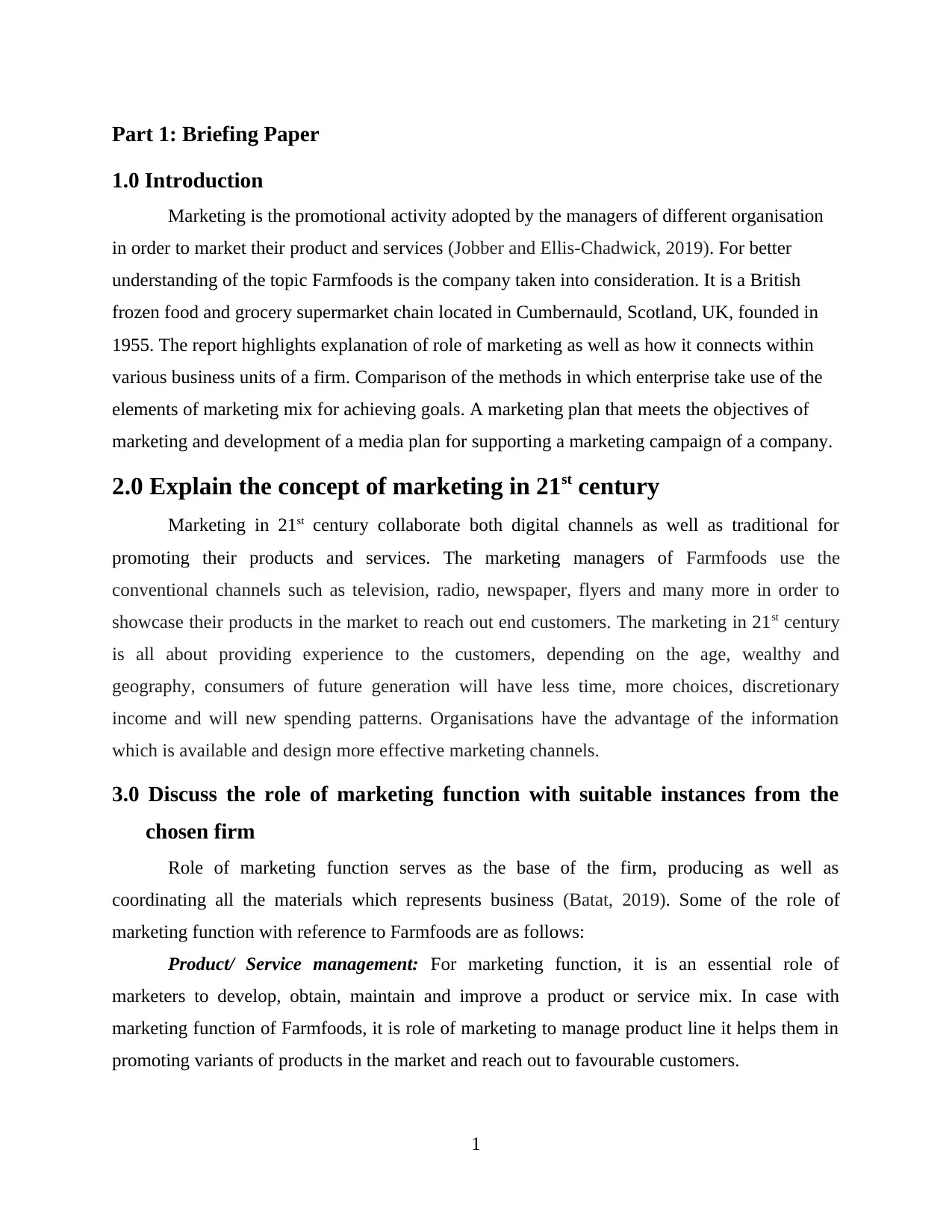
Part 1: Briefing Paper
1.0 Introduction
Marketing is the promotional activity adopted by the managers of different organisation
in order to market their product and services (Jobber and Ellis-Chadwick, 2019). For better
understanding of the topic Farmfoods is the company taken into consideration. It is a British
frozen food and grocery supermarket chain located in Cumbernauld, Scotland, UK, founded in
1955. The report highlights explanation of role of marketing as well as how it connects within
various business units of a firm. Comparison of the methods in which enterprise take use of the
elements of marketing mix for achieving goals. A marketing plan that meets the objectives of
marketing and development of a media plan for supporting a marketing campaign of a company.
2.0 Explain the concept of marketing in 21st century
Marketing in 21st century collaborate both digital channels as well as traditional for
promoting their products and services. The marketing managers of Farmfoods use the
conventional channels such as television, radio, newspaper, flyers and many more in order to
showcase their products in the market to reach out end customers. The marketing in 21st century
is all about providing experience to the customers, depending on the age, wealthy and
geography, consumers of future generation will have less time, more choices, discretionary
income and will new spending patterns. Organisations have the advantage of the information
which is available and design more effective marketing channels.
3.0 Discuss the role of marketing function with suitable instances from the
chosen firm
Role of marketing function serves as the base of the firm, producing as well as
coordinating all the materials which represents business (Batat, 2019). Some of the role of
marketing function with reference to Farmfoods are as follows:
Product/ Service management: For marketing function, it is an essential role of
marketers to develop, obtain, maintain and improve a product or service mix. In case with
marketing function of Farmfoods, it is role of marketing to manage product line it helps them in
promoting variants of products in the market and reach out to favourable customers.
1
1.0 Introduction
Marketing is the promotional activity adopted by the managers of different organisation
in order to market their product and services (Jobber and Ellis-Chadwick, 2019). For better
understanding of the topic Farmfoods is the company taken into consideration. It is a British
frozen food and grocery supermarket chain located in Cumbernauld, Scotland, UK, founded in
1955. The report highlights explanation of role of marketing as well as how it connects within
various business units of a firm. Comparison of the methods in which enterprise take use of the
elements of marketing mix for achieving goals. A marketing plan that meets the objectives of
marketing and development of a media plan for supporting a marketing campaign of a company.
2.0 Explain the concept of marketing in 21st century
Marketing in 21st century collaborate both digital channels as well as traditional for
promoting their products and services. The marketing managers of Farmfoods use the
conventional channels such as television, radio, newspaper, flyers and many more in order to
showcase their products in the market to reach out end customers. The marketing in 21st century
is all about providing experience to the customers, depending on the age, wealthy and
geography, consumers of future generation will have less time, more choices, discretionary
income and will new spending patterns. Organisations have the advantage of the information
which is available and design more effective marketing channels.
3.0 Discuss the role of marketing function with suitable instances from the
chosen firm
Role of marketing function serves as the base of the firm, producing as well as
coordinating all the materials which represents business (Batat, 2019). Some of the role of
marketing function with reference to Farmfoods are as follows:
Product/ Service management: For marketing function, it is an essential role of
marketers to develop, obtain, maintain and improve a product or service mix. In case with
marketing function of Farmfoods, it is role of marketing to manage product line it helps them in
promoting variants of products in the market and reach out to favourable customers.
1
Secure Best Marks with AI Grader
Need help grading? Try our AI Grader for instant feedback on your assignments.
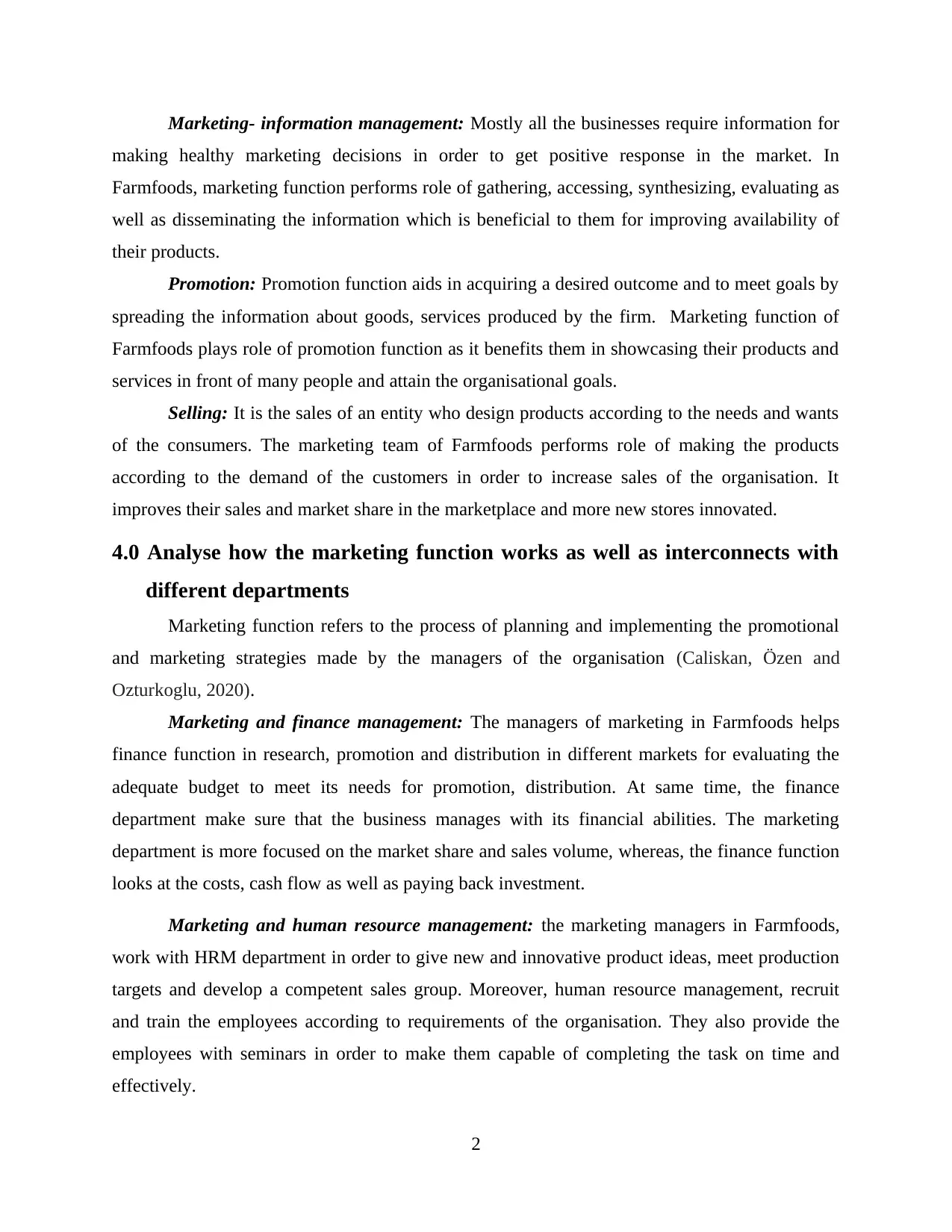
Marketing- information management: Mostly all the businesses require information for
making healthy marketing decisions in order to get positive response in the market. In
Farmfoods, marketing function performs role of gathering, accessing, synthesizing, evaluating as
well as disseminating the information which is beneficial to them for improving availability of
their products.
Promotion: Promotion function aids in acquiring a desired outcome and to meet goals by
spreading the information about goods, services produced by the firm. Marketing function of
Farmfoods plays role of promotion function as it benefits them in showcasing their products and
services in front of many people and attain the organisational goals.
Selling: It is the sales of an entity who design products according to the needs and wants
of the consumers. The marketing team of Farmfoods performs role of making the products
according to the demand of the customers in order to increase sales of the organisation. It
improves their sales and market share in the marketplace and more new stores innovated.
4.0 Analyse how the marketing function works as well as interconnects with
different departments
Marketing function refers to the process of planning and implementing the promotional
and marketing strategies made by the managers of the organisation (Caliskan, Özen and
Ozturkoglu, 2020).
Marketing and finance management: The managers of marketing in Farmfoods helps
finance function in research, promotion and distribution in different markets for evaluating the
adequate budget to meet its needs for promotion, distribution. At same time, the finance
department make sure that the business manages with its financial abilities. The marketing
department is more focused on the market share and sales volume, whereas, the finance function
looks at the costs, cash flow as well as paying back investment.
Marketing and human resource management: the marketing managers in Farmfoods,
work with HRM department in order to give new and innovative product ideas, meet production
targets and develop a competent sales group. Moreover, human resource management, recruit
and train the employees according to requirements of the organisation. They also provide the
employees with seminars in order to make them capable of completing the task on time and
effectively.
2
making healthy marketing decisions in order to get positive response in the market. In
Farmfoods, marketing function performs role of gathering, accessing, synthesizing, evaluating as
well as disseminating the information which is beneficial to them for improving availability of
their products.
Promotion: Promotion function aids in acquiring a desired outcome and to meet goals by
spreading the information about goods, services produced by the firm. Marketing function of
Farmfoods plays role of promotion function as it benefits them in showcasing their products and
services in front of many people and attain the organisational goals.
Selling: It is the sales of an entity who design products according to the needs and wants
of the consumers. The marketing team of Farmfoods performs role of making the products
according to the demand of the customers in order to increase sales of the organisation. It
improves their sales and market share in the marketplace and more new stores innovated.
4.0 Analyse how the marketing function works as well as interconnects with
different departments
Marketing function refers to the process of planning and implementing the promotional
and marketing strategies made by the managers of the organisation (Caliskan, Özen and
Ozturkoglu, 2020).
Marketing and finance management: The managers of marketing in Farmfoods helps
finance function in research, promotion and distribution in different markets for evaluating the
adequate budget to meet its needs for promotion, distribution. At same time, the finance
department make sure that the business manages with its financial abilities. The marketing
department is more focused on the market share and sales volume, whereas, the finance function
looks at the costs, cash flow as well as paying back investment.
Marketing and human resource management: the marketing managers in Farmfoods,
work with HRM department in order to give new and innovative product ideas, meet production
targets and develop a competent sales group. Moreover, human resource management, recruit
and train the employees according to requirements of the organisation. They also provide the
employees with seminars in order to make them capable of completing the task on time and
effectively.
2
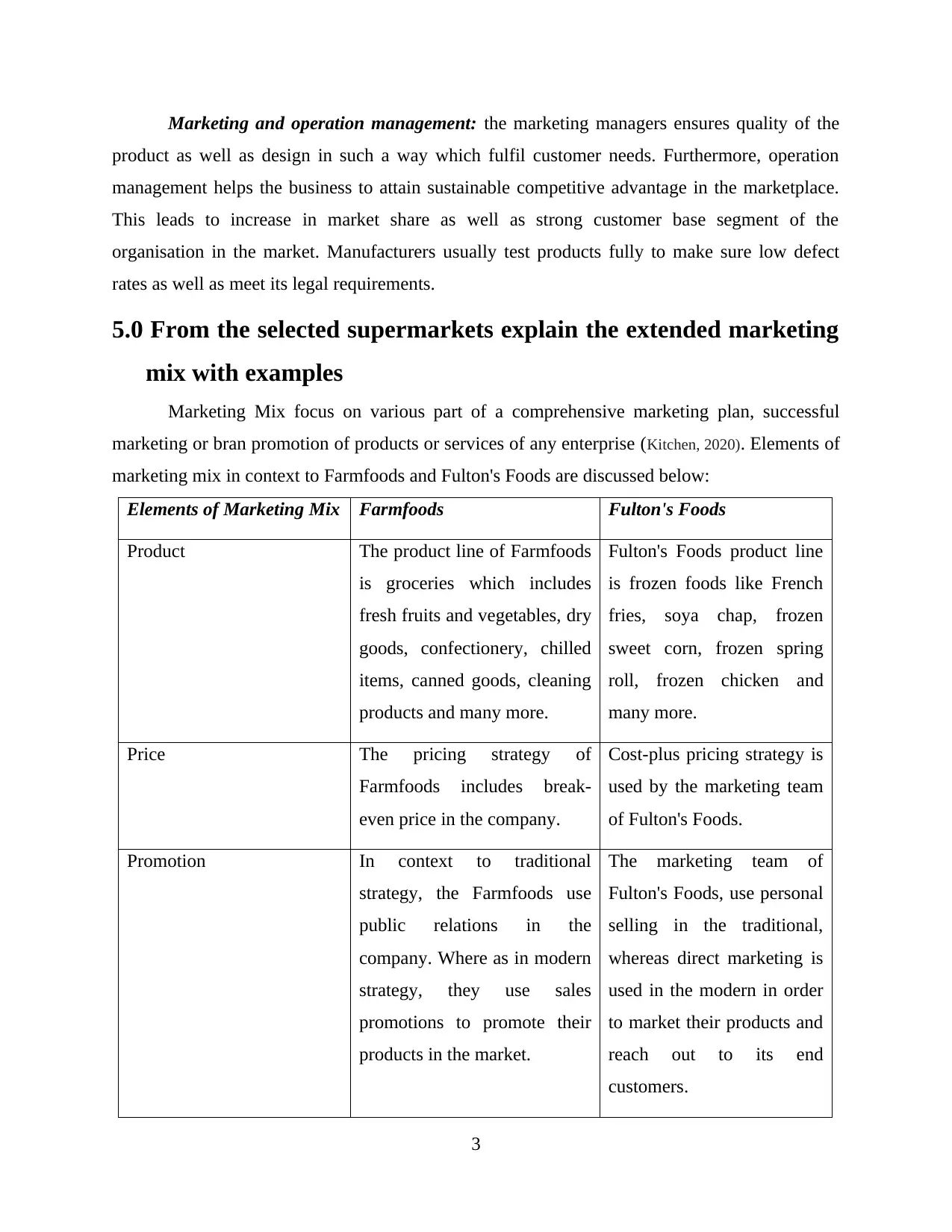
Marketing and operation management: the marketing managers ensures quality of the
product as well as design in such a way which fulfil customer needs. Furthermore, operation
management helps the business to attain sustainable competitive advantage in the marketplace.
This leads to increase in market share as well as strong customer base segment of the
organisation in the market. Manufacturers usually test products fully to make sure low defect
rates as well as meet its legal requirements.
5.0 From the selected supermarkets explain the extended marketing
mix with examples
Marketing Mix focus on various part of a comprehensive marketing plan, successful
marketing or bran promotion of products or services of any enterprise (Kitchen, 2020). Elements of
marketing mix in context to Farmfoods and Fulton's Foods are discussed below:
Elements of Marketing Mix Farmfoods Fulton's Foods
Product The product line of Farmfoods
is groceries which includes
fresh fruits and vegetables, dry
goods, confectionery, chilled
items, canned goods, cleaning
products and many more.
Fulton's Foods product line
is frozen foods like French
fries, soya chap, frozen
sweet corn, frozen spring
roll, frozen chicken and
many more.
Price The pricing strategy of
Farmfoods includes break-
even price in the company.
Cost-plus pricing strategy is
used by the marketing team
of Fulton's Foods.
Promotion In context to traditional
strategy, the Farmfoods use
public relations in the
company. Where as in modern
strategy, they use sales
promotions to promote their
products in the market.
The marketing team of
Fulton's Foods, use personal
selling in the traditional,
whereas direct marketing is
used in the modern in order
to market their products and
reach out to its end
customers.
3
product as well as design in such a way which fulfil customer needs. Furthermore, operation
management helps the business to attain sustainable competitive advantage in the marketplace.
This leads to increase in market share as well as strong customer base segment of the
organisation in the market. Manufacturers usually test products fully to make sure low defect
rates as well as meet its legal requirements.
5.0 From the selected supermarkets explain the extended marketing
mix with examples
Marketing Mix focus on various part of a comprehensive marketing plan, successful
marketing or bran promotion of products or services of any enterprise (Kitchen, 2020). Elements of
marketing mix in context to Farmfoods and Fulton's Foods are discussed below:
Elements of Marketing Mix Farmfoods Fulton's Foods
Product The product line of Farmfoods
is groceries which includes
fresh fruits and vegetables, dry
goods, confectionery, chilled
items, canned goods, cleaning
products and many more.
Fulton's Foods product line
is frozen foods like French
fries, soya chap, frozen
sweet corn, frozen spring
roll, frozen chicken and
many more.
Price The pricing strategy of
Farmfoods includes break-
even price in the company.
Cost-plus pricing strategy is
used by the marketing team
of Fulton's Foods.
Promotion In context to traditional
strategy, the Farmfoods use
public relations in the
company. Where as in modern
strategy, they use sales
promotions to promote their
products in the market.
The marketing team of
Fulton's Foods, use personal
selling in the traditional,
whereas direct marketing is
used in the modern in order
to market their products and
reach out to its end
customers.
3
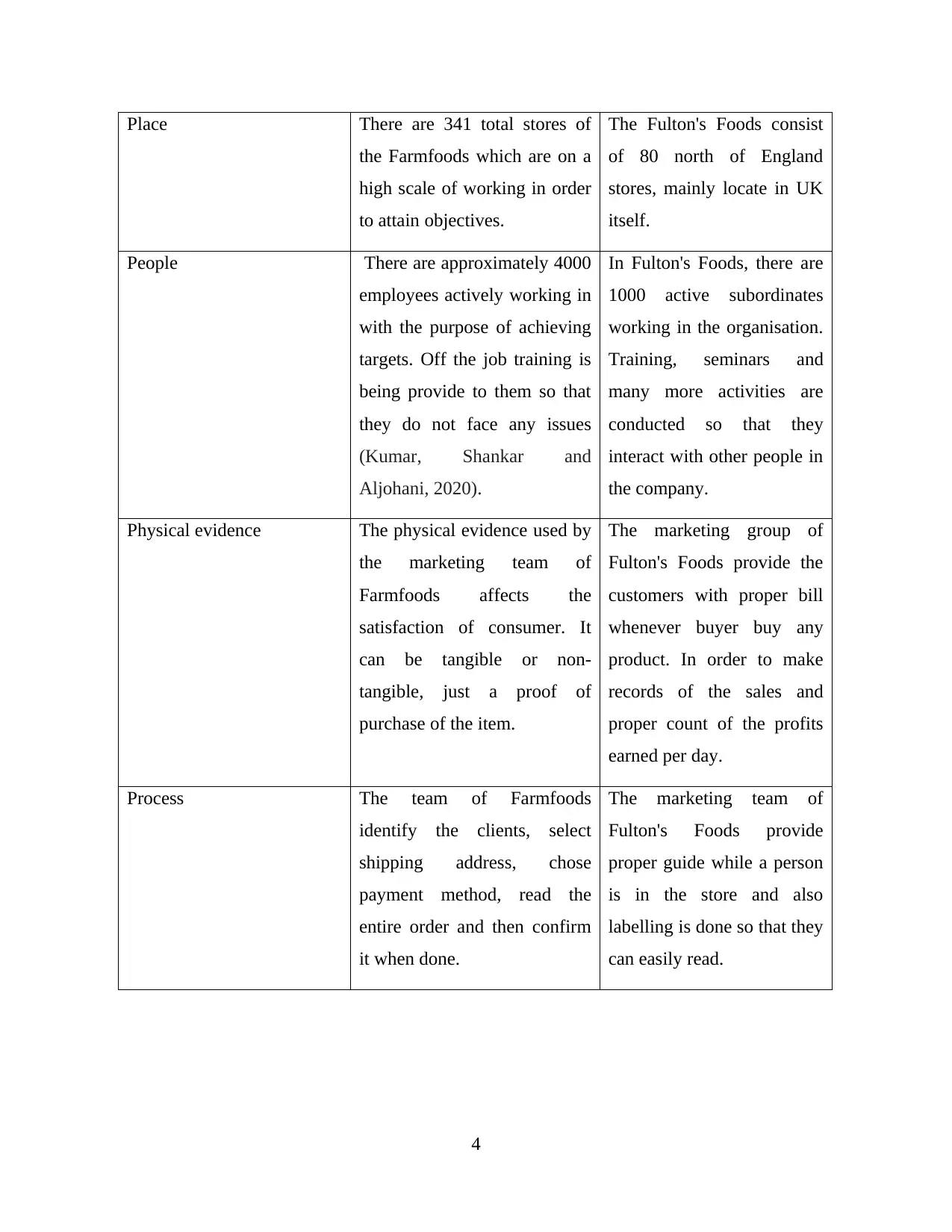
Place There are 341 total stores of
the Farmfoods which are on a
high scale of working in order
to attain objectives.
The Fulton's Foods consist
of 80 north of England
stores, mainly locate in UK
itself.
People There are approximately 4000
employees actively working in
with the purpose of achieving
targets. Off the job training is
being provide to them so that
they do not face any issues
(Kumar, Shankar and
Aljohani, 2020).
In Fulton's Foods, there are
1000 active subordinates
working in the organisation.
Training, seminars and
many more activities are
conducted so that they
interact with other people in
the company.
Physical evidence The physical evidence used by
the marketing team of
Farmfoods affects the
satisfaction of consumer. It
can be tangible or non-
tangible, just a proof of
purchase of the item.
The marketing group of
Fulton's Foods provide the
customers with proper bill
whenever buyer buy any
product. In order to make
records of the sales and
proper count of the profits
earned per day.
Process The team of Farmfoods
identify the clients, select
shipping address, chose
payment method, read the
entire order and then confirm
it when done.
The marketing team of
Fulton's Foods provide
proper guide while a person
is in the store and also
labelling is done so that they
can easily read.
4
the Farmfoods which are on a
high scale of working in order
to attain objectives.
The Fulton's Foods consist
of 80 north of England
stores, mainly locate in UK
itself.
People There are approximately 4000
employees actively working in
with the purpose of achieving
targets. Off the job training is
being provide to them so that
they do not face any issues
(Kumar, Shankar and
Aljohani, 2020).
In Fulton's Foods, there are
1000 active subordinates
working in the organisation.
Training, seminars and
many more activities are
conducted so that they
interact with other people in
the company.
Physical evidence The physical evidence used by
the marketing team of
Farmfoods affects the
satisfaction of consumer. It
can be tangible or non-
tangible, just a proof of
purchase of the item.
The marketing group of
Fulton's Foods provide the
customers with proper bill
whenever buyer buy any
product. In order to make
records of the sales and
proper count of the profits
earned per day.
Process The team of Farmfoods
identify the clients, select
shipping address, chose
payment method, read the
entire order and then confirm
it when done.
The marketing team of
Fulton's Foods provide
proper guide while a person
is in the store and also
labelling is done so that they
can easily read.
4
Paraphrase This Document
Need a fresh take? Get an instant paraphrase of this document with our AI Paraphraser
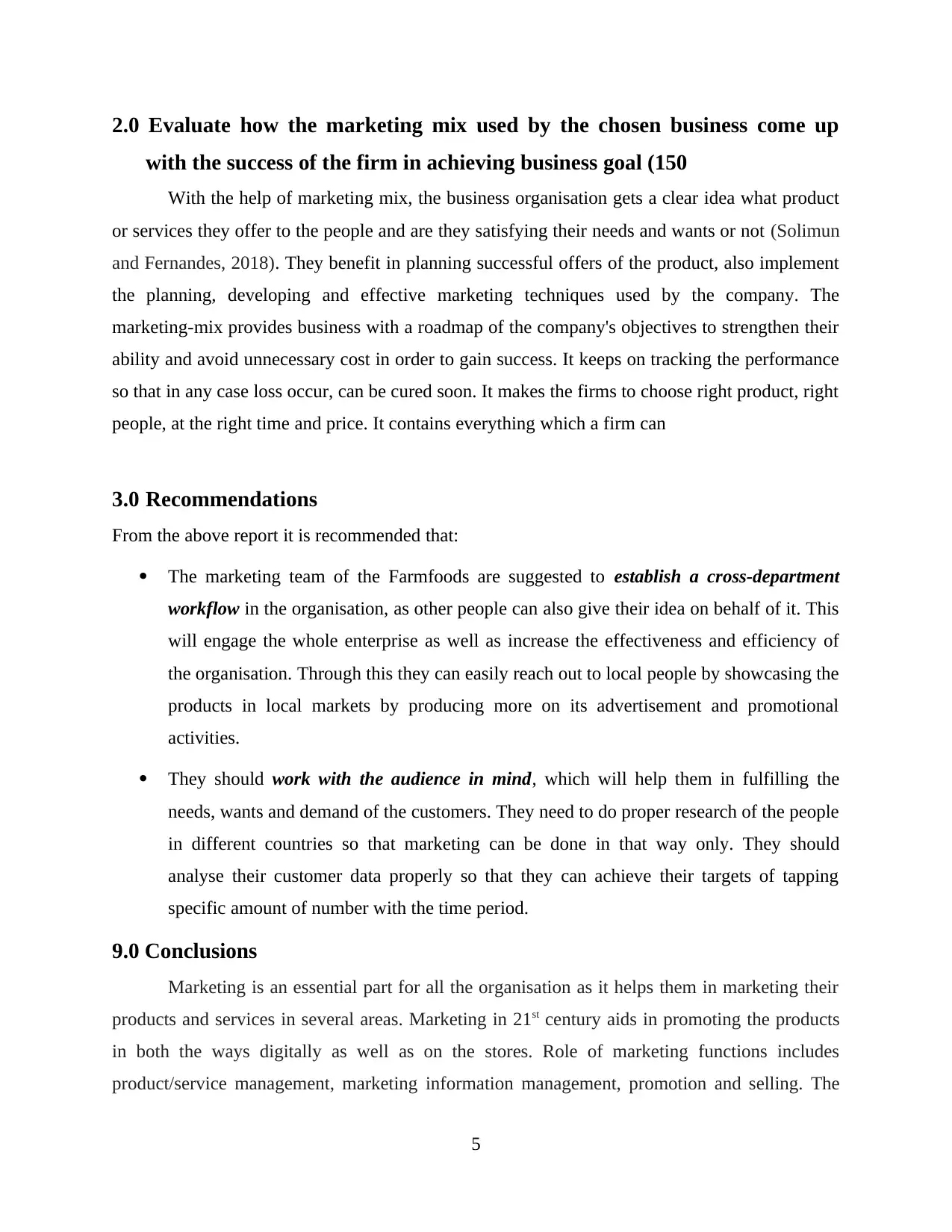
2.0 Evaluate how the marketing mix used by the chosen business come up
with the success of the firm in achieving business goal (150
With the help of marketing mix, the business organisation gets a clear idea what product
or services they offer to the people and are they satisfying their needs and wants or not (Solimun
and Fernandes, 2018). They benefit in planning successful offers of the product, also implement
the planning, developing and effective marketing techniques used by the company. The
marketing-mix provides business with a roadmap of the company's objectives to strengthen their
ability and avoid unnecessary cost in order to gain success. It keeps on tracking the performance
so that in any case loss occur, can be cured soon. It makes the firms to choose right product, right
people, at the right time and price. It contains everything which a firm can
3.0 Recommendations
From the above report it is recommended that:
The marketing team of the Farmfoods are suggested to establish a cross-department
workflow in the organisation, as other people can also give their idea on behalf of it. This
will engage the whole enterprise as well as increase the effectiveness and efficiency of
the organisation. Through this they can easily reach out to local people by showcasing the
products in local markets by producing more on its advertisement and promotional
activities.
They should work with the audience in mind, which will help them in fulfilling the
needs, wants and demand of the customers. They need to do proper research of the people
in different countries so that marketing can be done in that way only. They should
analyse their customer data properly so that they can achieve their targets of tapping
specific amount of number with the time period.
9.0 Conclusions
Marketing is an essential part for all the organisation as it helps them in marketing their
products and services in several areas. Marketing in 21st century aids in promoting the products
in both the ways digitally as well as on the stores. Role of marketing functions includes
product/service management, marketing information management, promotion and selling. The
5
with the success of the firm in achieving business goal (150
With the help of marketing mix, the business organisation gets a clear idea what product
or services they offer to the people and are they satisfying their needs and wants or not (Solimun
and Fernandes, 2018). They benefit in planning successful offers of the product, also implement
the planning, developing and effective marketing techniques used by the company. The
marketing-mix provides business with a roadmap of the company's objectives to strengthen their
ability and avoid unnecessary cost in order to gain success. It keeps on tracking the performance
so that in any case loss occur, can be cured soon. It makes the firms to choose right product, right
people, at the right time and price. It contains everything which a firm can
3.0 Recommendations
From the above report it is recommended that:
The marketing team of the Farmfoods are suggested to establish a cross-department
workflow in the organisation, as other people can also give their idea on behalf of it. This
will engage the whole enterprise as well as increase the effectiveness and efficiency of
the organisation. Through this they can easily reach out to local people by showcasing the
products in local markets by producing more on its advertisement and promotional
activities.
They should work with the audience in mind, which will help them in fulfilling the
needs, wants and demand of the customers. They need to do proper research of the people
in different countries so that marketing can be done in that way only. They should
analyse their customer data properly so that they can achieve their targets of tapping
specific amount of number with the time period.
9.0 Conclusions
Marketing is an essential part for all the organisation as it helps them in marketing their
products and services in several areas. Marketing in 21st century aids in promoting the products
in both the ways digitally as well as on the stores. Role of marketing functions includes
product/service management, marketing information management, promotion and selling. The
5
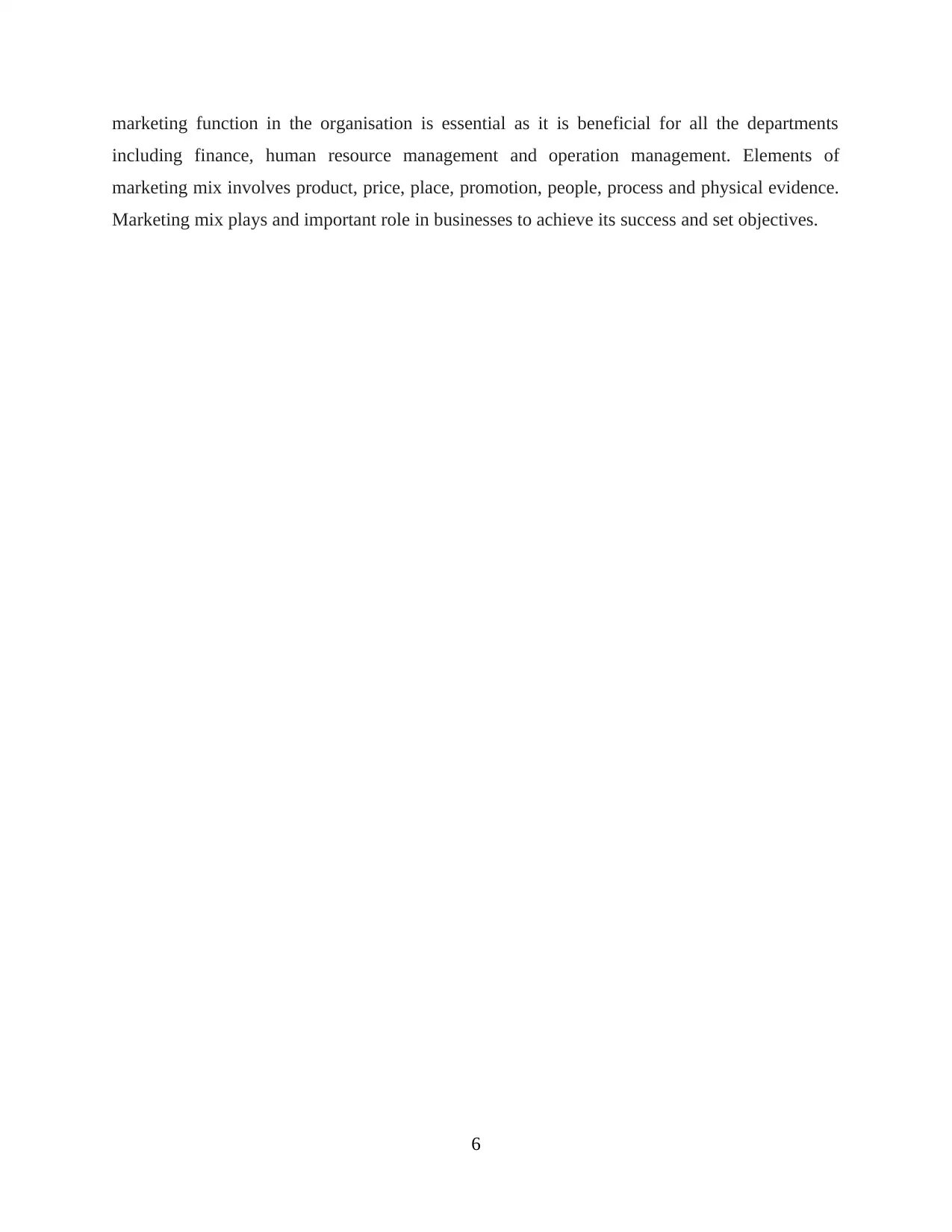
marketing function in the organisation is essential as it is beneficial for all the departments
including finance, human resource management and operation management. Elements of
marketing mix involves product, price, place, promotion, people, process and physical evidence.
Marketing mix plays and important role in businesses to achieve its success and set objectives.
6
including finance, human resource management and operation management. Elements of
marketing mix involves product, price, place, promotion, people, process and physical evidence.
Marketing mix plays and important role in businesses to achieve its success and set objectives.
6

7
Secure Best Marks with AI Grader
Need help grading? Try our AI Grader for instant feedback on your assignments.
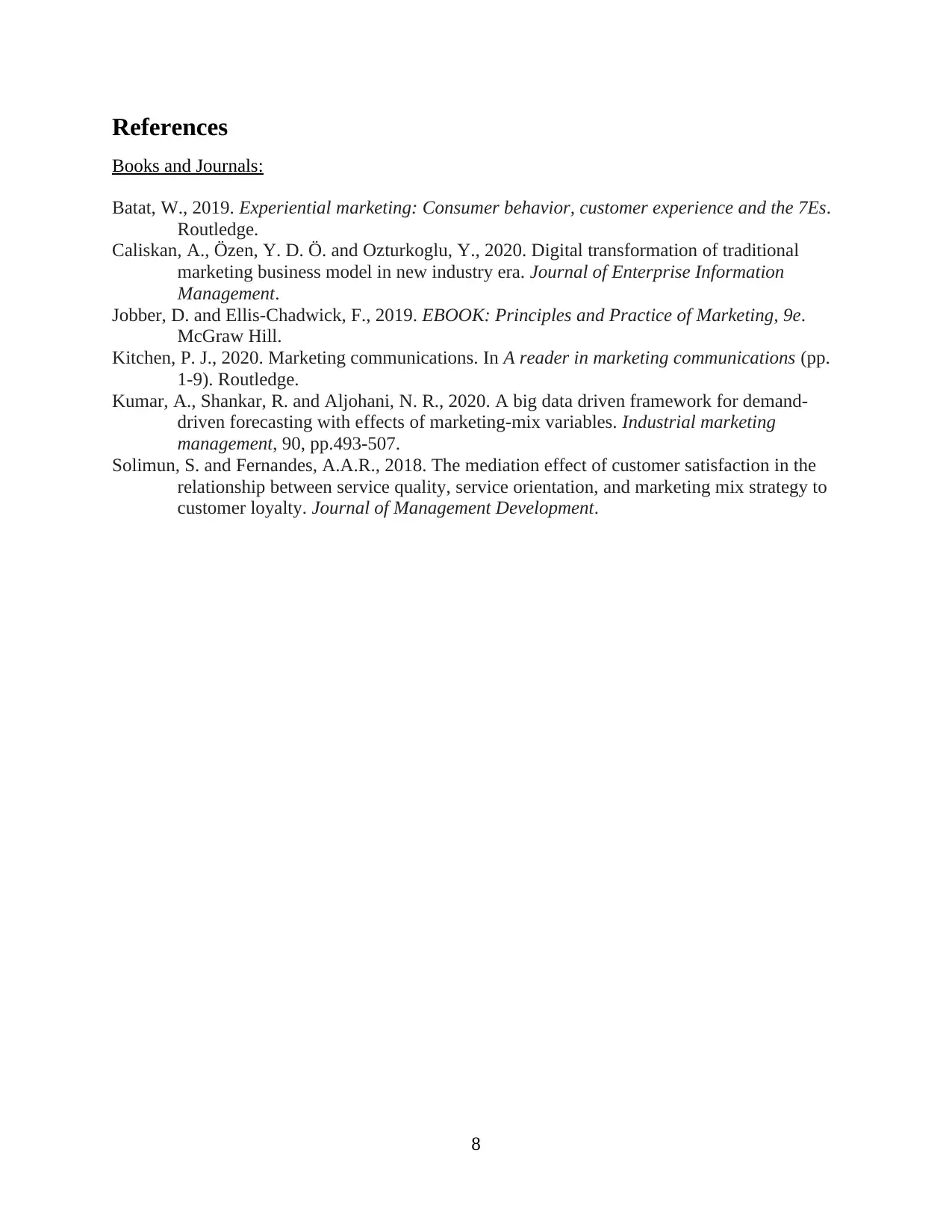
References
Books and Journals:
Batat, W., 2019. Experiential marketing: Consumer behavior, customer experience and the 7Es.
Routledge.
Caliskan, A., Özen, Y. D. Ö. and Ozturkoglu, Y., 2020. Digital transformation of traditional
marketing business model in new industry era. Journal of Enterprise Information
Management.
Jobber, D. and Ellis-Chadwick, F., 2019. EBOOK: Principles and Practice of Marketing, 9e.
McGraw Hill.
Kitchen, P. J., 2020. Marketing communications. In A reader in marketing communications (pp.
1-9). Routledge.
Kumar, A., Shankar, R. and Aljohani, N. R., 2020. A big data driven framework for demand-
driven forecasting with effects of marketing-mix variables. Industrial marketing
management, 90, pp.493-507.
Solimun, S. and Fernandes, A.A.R., 2018. The mediation effect of customer satisfaction in the
relationship between service quality, service orientation, and marketing mix strategy to
customer loyalty. Journal of Management Development.
8
Books and Journals:
Batat, W., 2019. Experiential marketing: Consumer behavior, customer experience and the 7Es.
Routledge.
Caliskan, A., Özen, Y. D. Ö. and Ozturkoglu, Y., 2020. Digital transformation of traditional
marketing business model in new industry era. Journal of Enterprise Information
Management.
Jobber, D. and Ellis-Chadwick, F., 2019. EBOOK: Principles and Practice of Marketing, 9e.
McGraw Hill.
Kitchen, P. J., 2020. Marketing communications. In A reader in marketing communications (pp.
1-9). Routledge.
Kumar, A., Shankar, R. and Aljohani, N. R., 2020. A big data driven framework for demand-
driven forecasting with effects of marketing-mix variables. Industrial marketing
management, 90, pp.493-507.
Solimun, S. and Fernandes, A.A.R., 2018. The mediation effect of customer satisfaction in the
relationship between service quality, service orientation, and marketing mix strategy to
customer loyalty. Journal of Management Development.
8
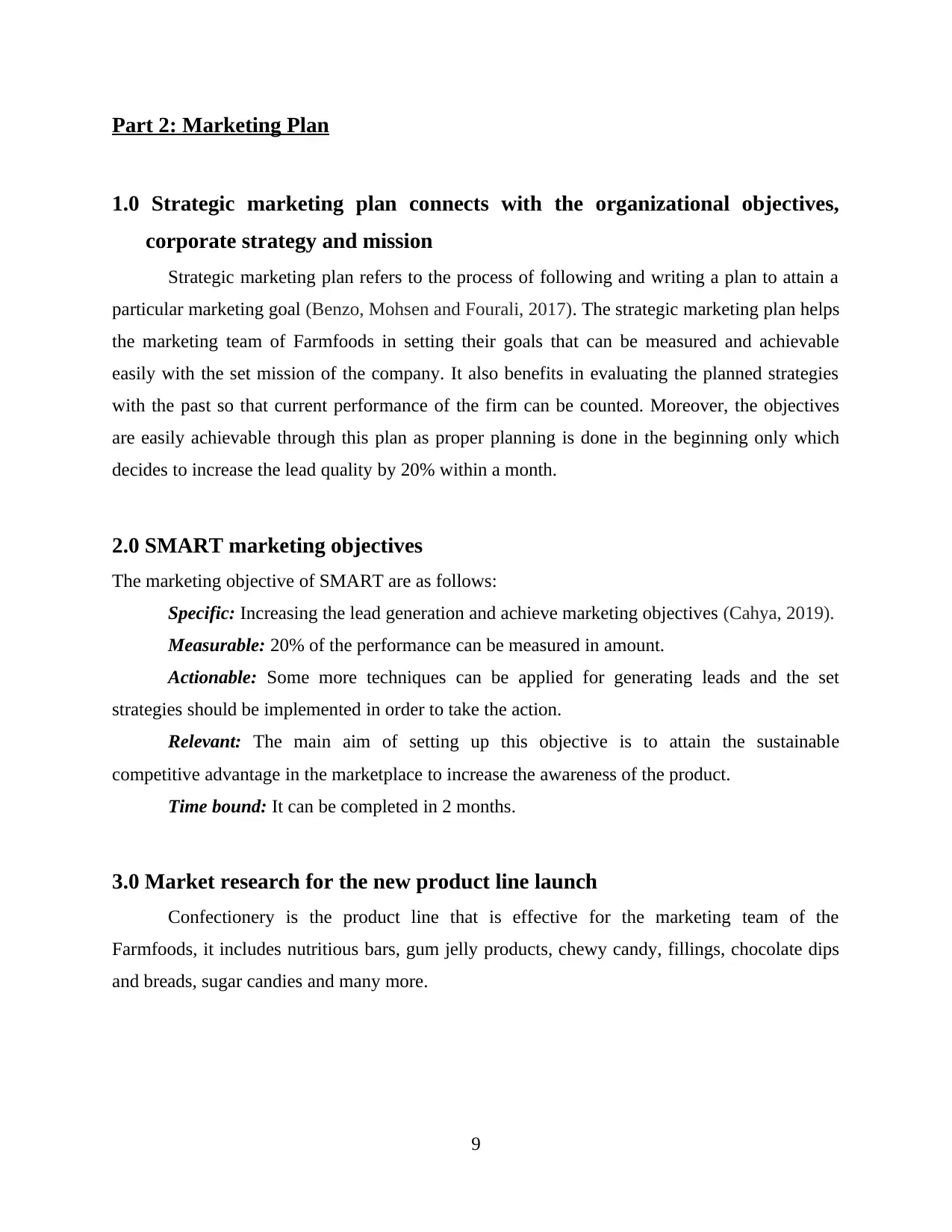
Part 2: Marketing Plan
1.0 Strategic marketing plan connects with the organizational objectives,
corporate strategy and mission
Strategic marketing plan refers to the process of following and writing a plan to attain a
particular marketing goal (Benzo, Mohsen and Fourali, 2017). The strategic marketing plan helps
the marketing team of Farmfoods in setting their goals that can be measured and achievable
easily with the set mission of the company. It also benefits in evaluating the planned strategies
with the past so that current performance of the firm can be counted. Moreover, the objectives
are easily achievable through this plan as proper planning is done in the beginning only which
decides to increase the lead quality by 20% within a month.
2.0 SMART marketing objectives
The marketing objective of SMART are as follows:
Specific: Increasing the lead generation and achieve marketing objectives (Cahya, 2019).
Measurable: 20% of the performance can be measured in amount.
Actionable: Some more techniques can be applied for generating leads and the set
strategies should be implemented in order to take the action.
Relevant: The main aim of setting up this objective is to attain the sustainable
competitive advantage in the marketplace to increase the awareness of the product.
Time bound: It can be completed in 2 months.
3.0 Market research for the new product line launch
Confectionery is the product line that is effective for the marketing team of the
Farmfoods, it includes nutritious bars, gum jelly products, chewy candy, fillings, chocolate dips
and breads, sugar candies and many more.
9
1.0 Strategic marketing plan connects with the organizational objectives,
corporate strategy and mission
Strategic marketing plan refers to the process of following and writing a plan to attain a
particular marketing goal (Benzo, Mohsen and Fourali, 2017). The strategic marketing plan helps
the marketing team of Farmfoods in setting their goals that can be measured and achievable
easily with the set mission of the company. It also benefits in evaluating the planned strategies
with the past so that current performance of the firm can be counted. Moreover, the objectives
are easily achievable through this plan as proper planning is done in the beginning only which
decides to increase the lead quality by 20% within a month.
2.0 SMART marketing objectives
The marketing objective of SMART are as follows:
Specific: Increasing the lead generation and achieve marketing objectives (Cahya, 2019).
Measurable: 20% of the performance can be measured in amount.
Actionable: Some more techniques can be applied for generating leads and the set
strategies should be implemented in order to take the action.
Relevant: The main aim of setting up this objective is to attain the sustainable
competitive advantage in the marketplace to increase the awareness of the product.
Time bound: It can be completed in 2 months.
3.0 Market research for the new product line launch
Confectionery is the product line that is effective for the marketing team of the
Farmfoods, it includes nutritious bars, gum jelly products, chewy candy, fillings, chocolate dips
and breads, sugar candies and many more.
9
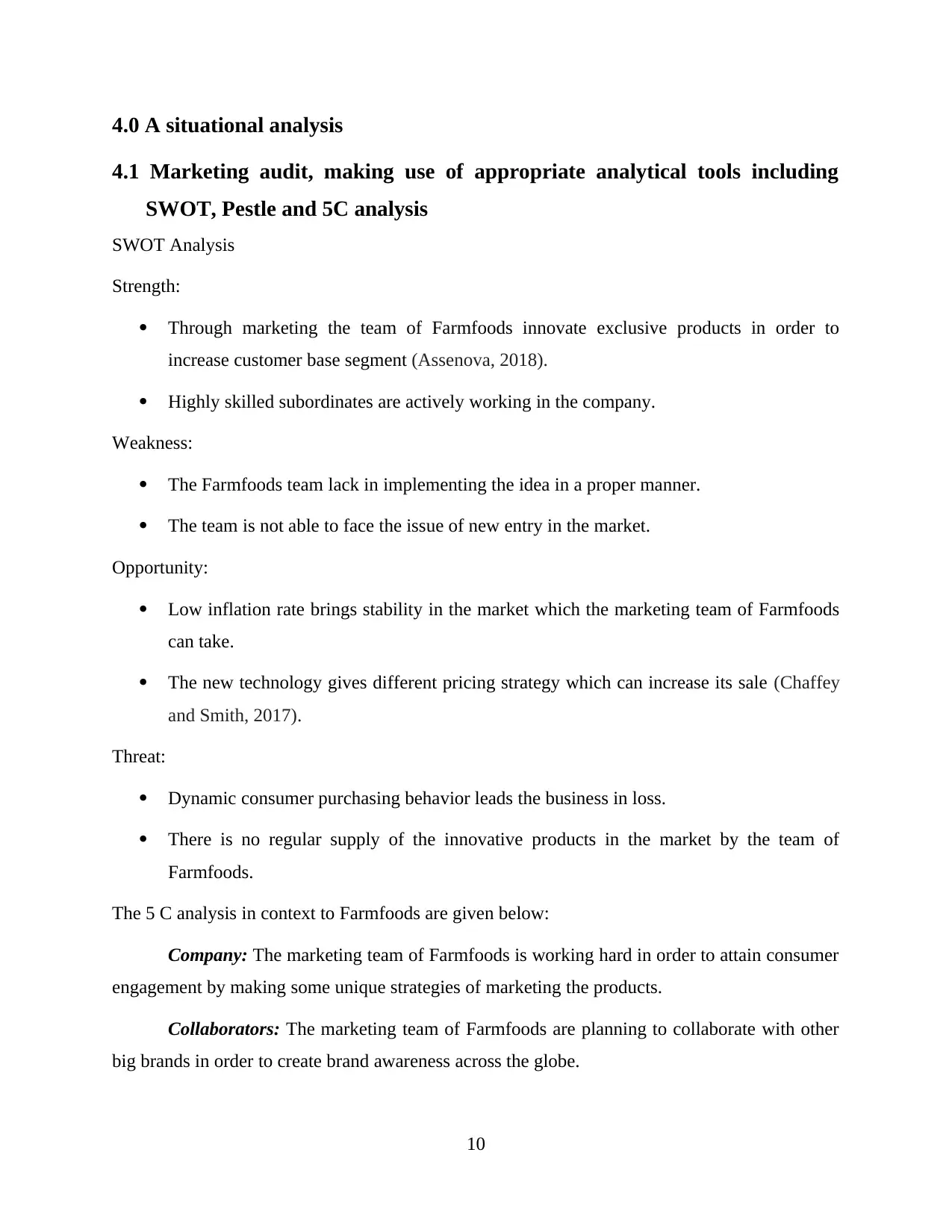
4.0 A situational analysis
4.1 Marketing audit, making use of appropriate analytical tools including
SWOT, Pestle and 5C analysis
SWOT Analysis
Strength:
Through marketing the team of Farmfoods innovate exclusive products in order to
increase customer base segment (Assenova, 2018).
Highly skilled subordinates are actively working in the company.
Weakness:
The Farmfoods team lack in implementing the idea in a proper manner.
The team is not able to face the issue of new entry in the market.
Opportunity:
Low inflation rate brings stability in the market which the marketing team of Farmfoods
can take.
The new technology gives different pricing strategy which can increase its sale (Chaffey
and Smith, 2017).
Threat:
Dynamic consumer purchasing behavior leads the business in loss.
There is no regular supply of the innovative products in the market by the team of
Farmfoods.
The 5 C analysis in context to Farmfoods are given below:
Company: The marketing team of Farmfoods is working hard in order to attain consumer
engagement by making some unique strategies of marketing the products.
Collaborators: The marketing team of Farmfoods are planning to collaborate with other
big brands in order to create brand awareness across the globe.
10
4.1 Marketing audit, making use of appropriate analytical tools including
SWOT, Pestle and 5C analysis
SWOT Analysis
Strength:
Through marketing the team of Farmfoods innovate exclusive products in order to
increase customer base segment (Assenova, 2018).
Highly skilled subordinates are actively working in the company.
Weakness:
The Farmfoods team lack in implementing the idea in a proper manner.
The team is not able to face the issue of new entry in the market.
Opportunity:
Low inflation rate brings stability in the market which the marketing team of Farmfoods
can take.
The new technology gives different pricing strategy which can increase its sale (Chaffey
and Smith, 2017).
Threat:
Dynamic consumer purchasing behavior leads the business in loss.
There is no regular supply of the innovative products in the market by the team of
Farmfoods.
The 5 C analysis in context to Farmfoods are given below:
Company: The marketing team of Farmfoods is working hard in order to attain consumer
engagement by making some unique strategies of marketing the products.
Collaborators: The marketing team of Farmfoods are planning to collaborate with other
big brands in order to create brand awareness across the globe.
10
Paraphrase This Document
Need a fresh take? Get an instant paraphrase of this document with our AI Paraphraser

Customers: The target customer base decided by the Farmfoods team are middle class
people who can afford to fulfill their basic needs by purchasing products from the store.
Competitors: The team of Farmfoods are facing huge competition with Heron Foods
Ltd., Budgens, Arcadia Group Ltd. and many more.
Climate: The Farmfoods team are working on the sustainability of the brand by reducing
the use of plastic packages.
4.2 A competitor analysis including the market segments
Basis of analysis Farmfoods Jumbo grocery store
Demographic segmentation The marketing team of
Farmfoods includes
segmentation on the basis of
gender, age and occupation.
Whereas, it market
segmentation is done on the
basis of cultural background
and family status.
Behavioural segmentation This behavioural segmentation
is segmented on the basis of its
loyalty, usage rate and so on.
In the Jumbo grocery the team
is diversified on the basis of
online shopping habits, actions
taken on a website and benefits
sought.
Geographic segmentation The team of Farmfoods divide
on the basis of location of the
marketplace.
They also use the same
segment for their organisation
which is Jumbo grocery store.
4.3 Sub-segments
The marketing team of Farmfoods use the demographic segmentation which includes the
segmentation on the basis of gender, it can be any human across the globe, in age they are
targeting mainly 18 – 40 years of age group. In the behavioral segmentation, the team is planning
to create brand loyalty in the market to increase more customers. The usage rate is the consumer
consumes that particular product with a period of time so that they can purchase it again
whenever required (Chernev, 2020). In the geographic segmentation the Farmfoods team is
11
people who can afford to fulfill their basic needs by purchasing products from the store.
Competitors: The team of Farmfoods are facing huge competition with Heron Foods
Ltd., Budgens, Arcadia Group Ltd. and many more.
Climate: The Farmfoods team are working on the sustainability of the brand by reducing
the use of plastic packages.
4.2 A competitor analysis including the market segments
Basis of analysis Farmfoods Jumbo grocery store
Demographic segmentation The marketing team of
Farmfoods includes
segmentation on the basis of
gender, age and occupation.
Whereas, it market
segmentation is done on the
basis of cultural background
and family status.
Behavioural segmentation This behavioural segmentation
is segmented on the basis of its
loyalty, usage rate and so on.
In the Jumbo grocery the team
is diversified on the basis of
online shopping habits, actions
taken on a website and benefits
sought.
Geographic segmentation The team of Farmfoods divide
on the basis of location of the
marketplace.
They also use the same
segment for their organisation
which is Jumbo grocery store.
4.3 Sub-segments
The marketing team of Farmfoods use the demographic segmentation which includes the
segmentation on the basis of gender, it can be any human across the globe, in age they are
targeting mainly 18 – 40 years of age group. In the behavioral segmentation, the team is planning
to create brand loyalty in the market to increase more customers. The usage rate is the consumer
consumes that particular product with a period of time so that they can purchase it again
whenever required (Chernev, 2020). In the geographic segmentation the Farmfoods team is
11
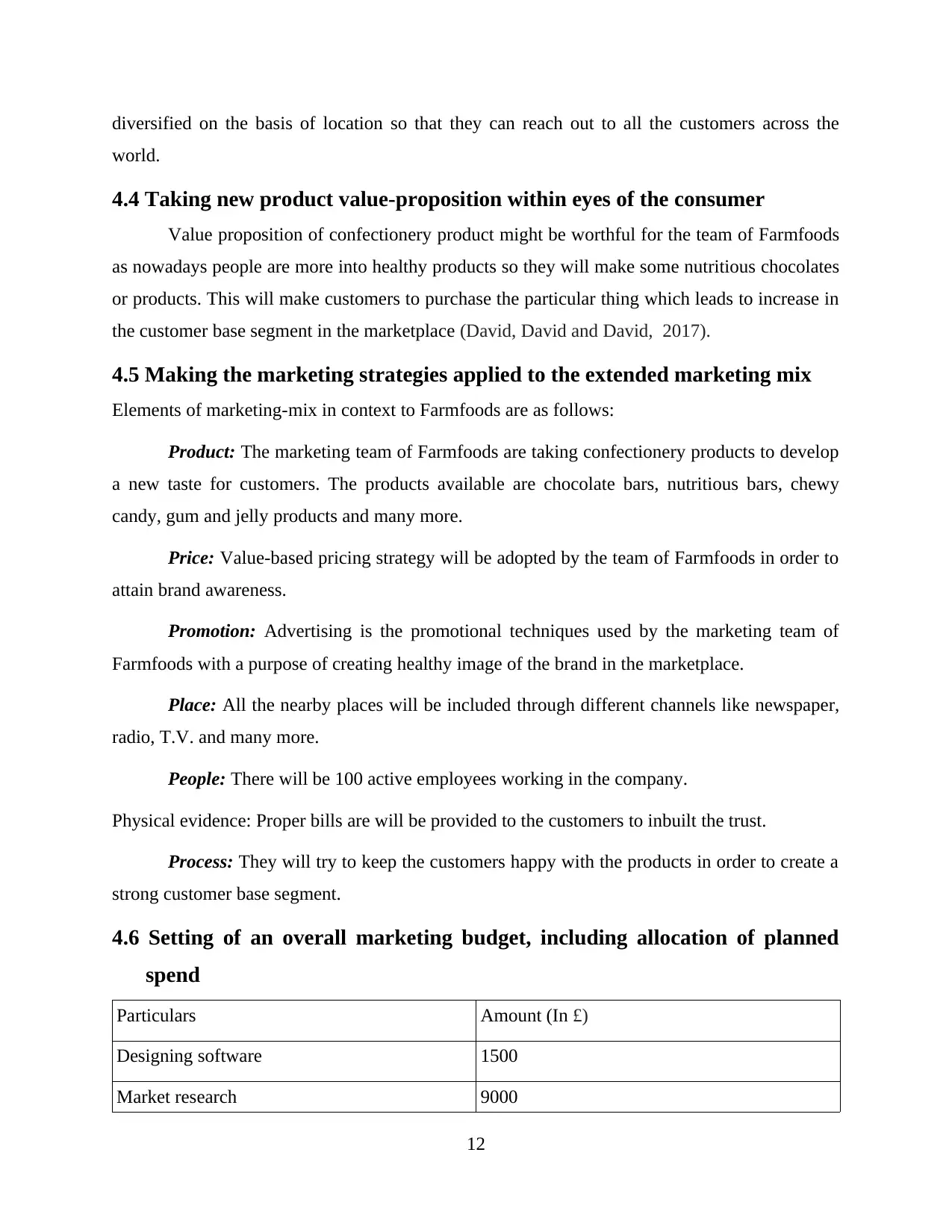
diversified on the basis of location so that they can reach out to all the customers across the
world.
4.4 Taking new product value-proposition within eyes of the consumer
Value proposition of confectionery product might be worthful for the team of Farmfoods
as nowadays people are more into healthy products so they will make some nutritious chocolates
or products. This will make customers to purchase the particular thing which leads to increase in
the customer base segment in the marketplace (David, David and David, 2017).
4.5 Making the marketing strategies applied to the extended marketing mix
Elements of marketing-mix in context to Farmfoods are as follows:
Product: The marketing team of Farmfoods are taking confectionery products to develop
a new taste for customers. The products available are chocolate bars, nutritious bars, chewy
candy, gum and jelly products and many more.
Price: Value-based pricing strategy will be adopted by the team of Farmfoods in order to
attain brand awareness.
Promotion: Advertising is the promotional techniques used by the marketing team of
Farmfoods with a purpose of creating healthy image of the brand in the marketplace.
Place: All the nearby places will be included through different channels like newspaper,
radio, T.V. and many more.
People: There will be 100 active employees working in the company.
Physical evidence: Proper bills are will be provided to the customers to inbuilt the trust.
Process: They will try to keep the customers happy with the products in order to create a
strong customer base segment.
4.6 Setting of an overall marketing budget, including allocation of planned
spend
Particulars Amount (In £)
Designing software 1500
Market research 9000
12
world.
4.4 Taking new product value-proposition within eyes of the consumer
Value proposition of confectionery product might be worthful for the team of Farmfoods
as nowadays people are more into healthy products so they will make some nutritious chocolates
or products. This will make customers to purchase the particular thing which leads to increase in
the customer base segment in the marketplace (David, David and David, 2017).
4.5 Making the marketing strategies applied to the extended marketing mix
Elements of marketing-mix in context to Farmfoods are as follows:
Product: The marketing team of Farmfoods are taking confectionery products to develop
a new taste for customers. The products available are chocolate bars, nutritious bars, chewy
candy, gum and jelly products and many more.
Price: Value-based pricing strategy will be adopted by the team of Farmfoods in order to
attain brand awareness.
Promotion: Advertising is the promotional techniques used by the marketing team of
Farmfoods with a purpose of creating healthy image of the brand in the marketplace.
Place: All the nearby places will be included through different channels like newspaper,
radio, T.V. and many more.
People: There will be 100 active employees working in the company.
Physical evidence: Proper bills are will be provided to the customers to inbuilt the trust.
Process: They will try to keep the customers happy with the products in order to create a
strong customer base segment.
4.6 Setting of an overall marketing budget, including allocation of planned
spend
Particulars Amount (In £)
Designing software 1500
Market research 9000
12
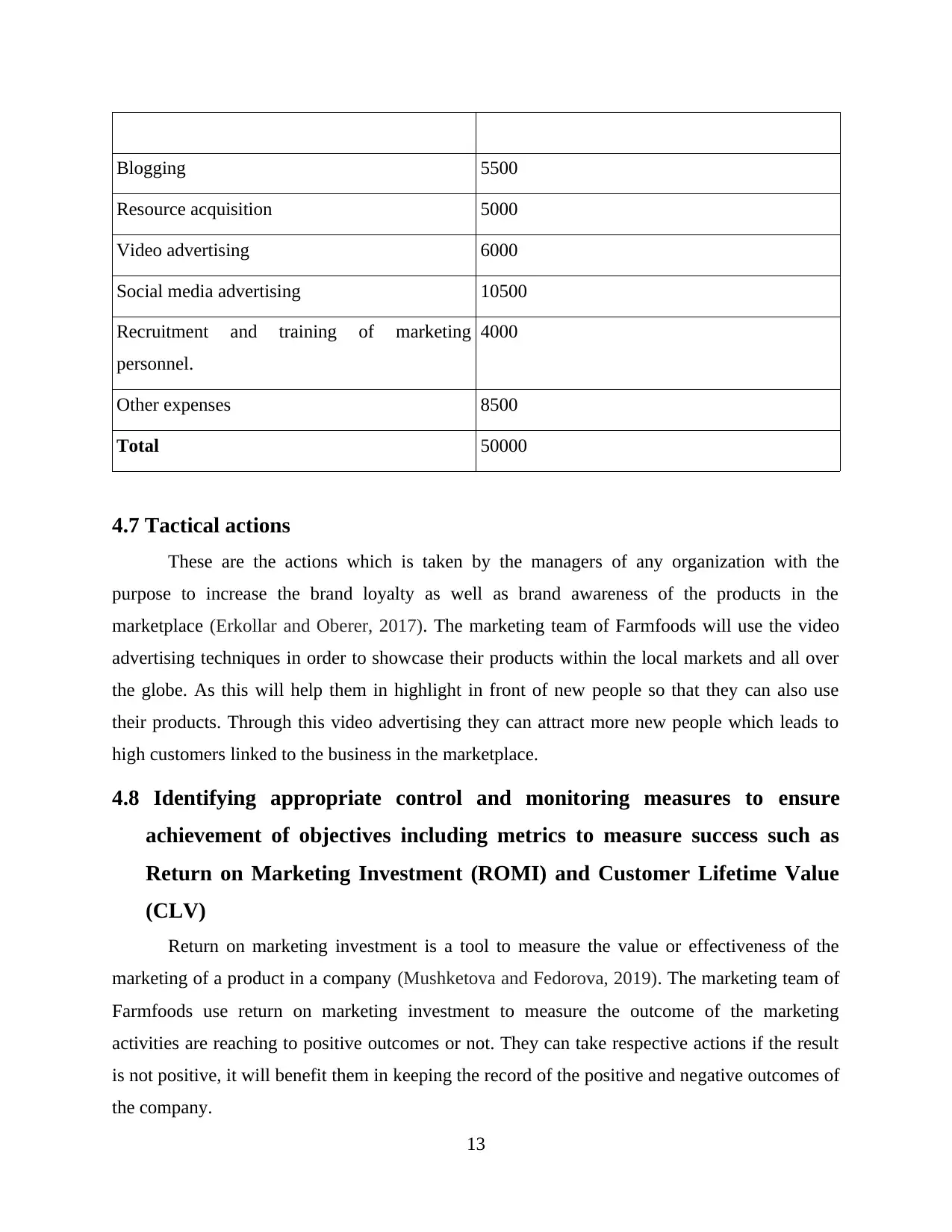
Blogging 5500
Resource acquisition 5000
Video advertising 6000
Social media advertising 10500
Recruitment and training of marketing
personnel.
4000
Other expenses 8500
Total 50000
4.7 Tactical actions
These are the actions which is taken by the managers of any organization with the
purpose to increase the brand loyalty as well as brand awareness of the products in the
marketplace (Erkollar and Oberer, 2017). The marketing team of Farmfoods will use the video
advertising techniques in order to showcase their products within the local markets and all over
the globe. As this will help them in highlight in front of new people so that they can also use
their products. Through this video advertising they can attract more new people which leads to
high customers linked to the business in the marketplace.
4.8 Identifying appropriate control and monitoring measures to ensure
achievement of objectives including metrics to measure success such as
Return on Marketing Investment (ROMI) and Customer Lifetime Value
(CLV)
Return on marketing investment is a tool to measure the value or effectiveness of the
marketing of a product in a company (Mushketova and Fedorova, 2019). The marketing team of
Farmfoods use return on marketing investment to measure the outcome of the marketing
activities are reaching to positive outcomes or not. They can take respective actions if the result
is not positive, it will benefit them in keeping the record of the positive and negative outcomes of
the company.
13
Resource acquisition 5000
Video advertising 6000
Social media advertising 10500
Recruitment and training of marketing
personnel.
4000
Other expenses 8500
Total 50000
4.7 Tactical actions
These are the actions which is taken by the managers of any organization with the
purpose to increase the brand loyalty as well as brand awareness of the products in the
marketplace (Erkollar and Oberer, 2017). The marketing team of Farmfoods will use the video
advertising techniques in order to showcase their products within the local markets and all over
the globe. As this will help them in highlight in front of new people so that they can also use
their products. Through this video advertising they can attract more new people which leads to
high customers linked to the business in the marketplace.
4.8 Identifying appropriate control and monitoring measures to ensure
achievement of objectives including metrics to measure success such as
Return on Marketing Investment (ROMI) and Customer Lifetime Value
(CLV)
Return on marketing investment is a tool to measure the value or effectiveness of the
marketing of a product in a company (Mushketova and Fedorova, 2019). The marketing team of
Farmfoods use return on marketing investment to measure the outcome of the marketing
activities are reaching to positive outcomes or not. They can take respective actions if the result
is not positive, it will benefit them in keeping the record of the positive and negative outcomes of
the company.
13
Secure Best Marks with AI Grader
Need help grading? Try our AI Grader for instant feedback on your assignments.
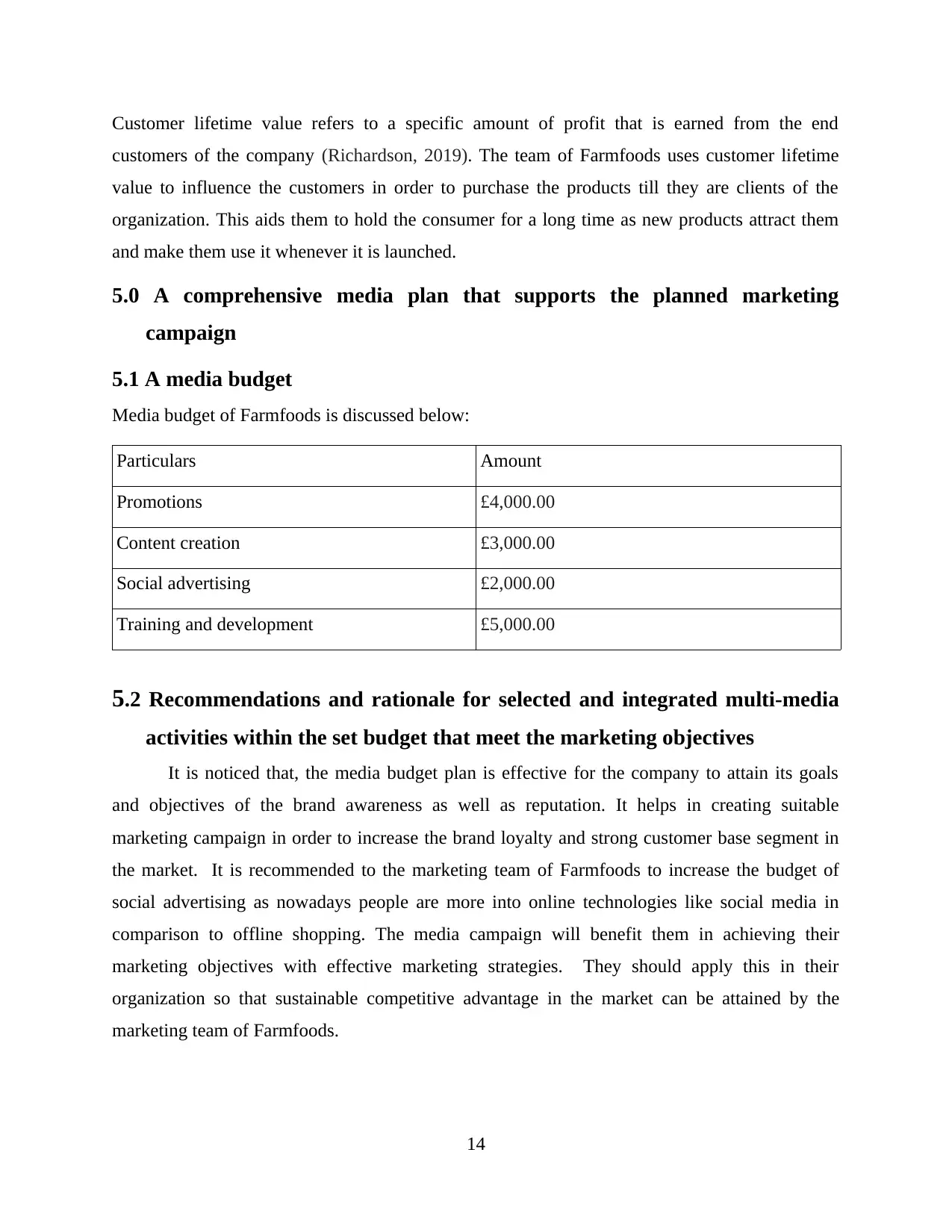
Customer lifetime value refers to a specific amount of profit that is earned from the end
customers of the company (Richardson, 2019). The team of Farmfoods uses customer lifetime
value to influence the customers in order to purchase the products till they are clients of the
organization. This aids them to hold the consumer for a long time as new products attract them
and make them use it whenever it is launched.
5.0 A comprehensive media plan that supports the planned marketing
campaign
5.1 A media budget
Media budget of Farmfoods is discussed below:
Particulars Amount
Promotions £4,000.00
Content creation £3,000.00
Social advertising £2,000.00
Training and development £5,000.00
5.2 Recommendations and rationale for selected and integrated multi-media
activities within the set budget that meet the marketing objectives
It is noticed that, the media budget plan is effective for the company to attain its goals
and objectives of the brand awareness as well as reputation. It helps in creating suitable
marketing campaign in order to increase the brand loyalty and strong customer base segment in
the market. It is recommended to the marketing team of Farmfoods to increase the budget of
social advertising as nowadays people are more into online technologies like social media in
comparison to offline shopping. The media campaign will benefit them in achieving their
marketing objectives with effective marketing strategies. They should apply this in their
organization so that sustainable competitive advantage in the market can be attained by the
marketing team of Farmfoods.
14
customers of the company (Richardson, 2019). The team of Farmfoods uses customer lifetime
value to influence the customers in order to purchase the products till they are clients of the
organization. This aids them to hold the consumer for a long time as new products attract them
and make them use it whenever it is launched.
5.0 A comprehensive media plan that supports the planned marketing
campaign
5.1 A media budget
Media budget of Farmfoods is discussed below:
Particulars Amount
Promotions £4,000.00
Content creation £3,000.00
Social advertising £2,000.00
Training and development £5,000.00
5.2 Recommendations and rationale for selected and integrated multi-media
activities within the set budget that meet the marketing objectives
It is noticed that, the media budget plan is effective for the company to attain its goals
and objectives of the brand awareness as well as reputation. It helps in creating suitable
marketing campaign in order to increase the brand loyalty and strong customer base segment in
the market. It is recommended to the marketing team of Farmfoods to increase the budget of
social advertising as nowadays people are more into online technologies like social media in
comparison to offline shopping. The media campaign will benefit them in achieving their
marketing objectives with effective marketing strategies. They should apply this in their
organization so that sustainable competitive advantage in the market can be attained by the
marketing team of Farmfoods.
14
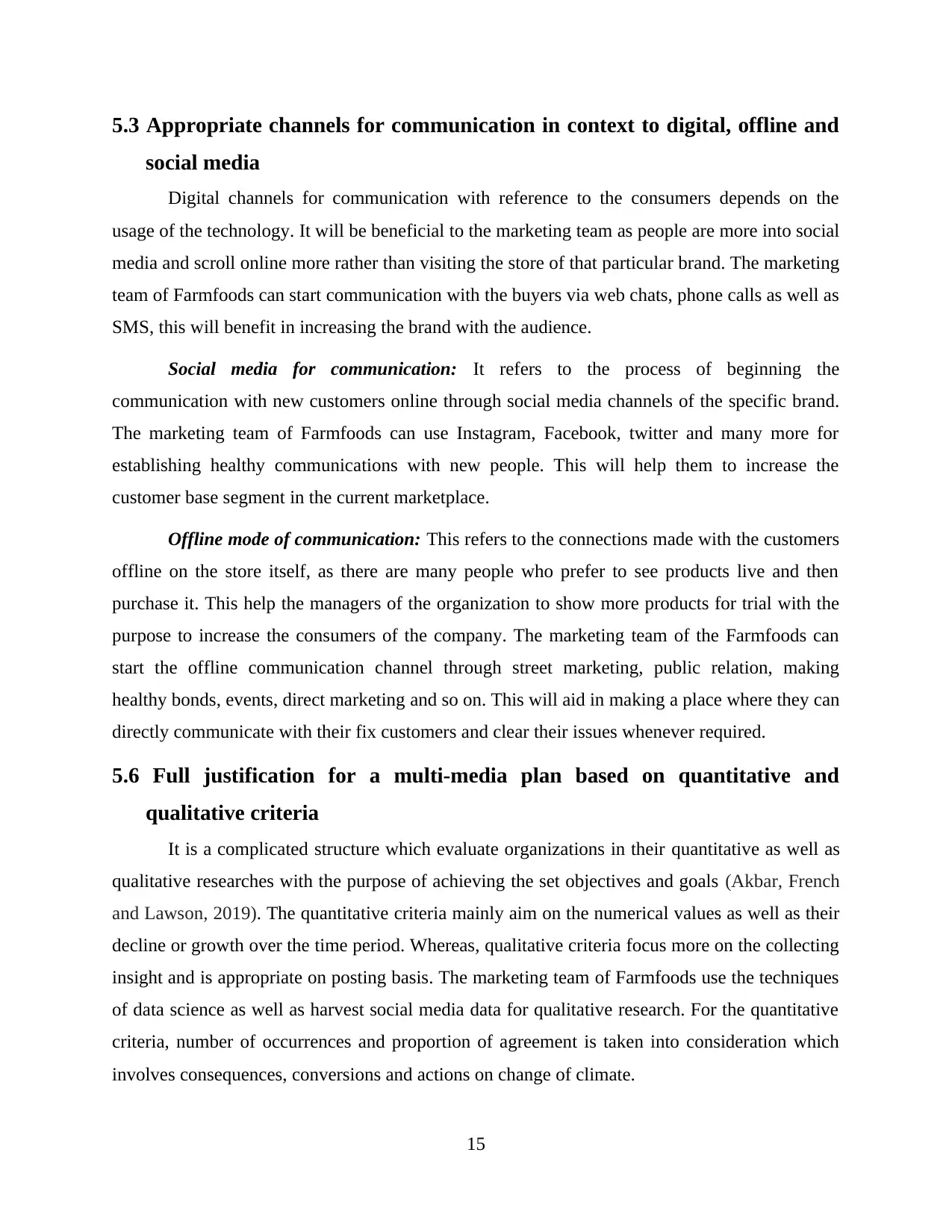
5.3 Appropriate channels for communication in context to digital, offline and
social media
Digital channels for communication with reference to the consumers depends on the
usage of the technology. It will be beneficial to the marketing team as people are more into social
media and scroll online more rather than visiting the store of that particular brand. The marketing
team of Farmfoods can start communication with the buyers via web chats, phone calls as well as
SMS, this will benefit in increasing the brand with the audience.
Social media for communication: It refers to the process of beginning the
communication with new customers online through social media channels of the specific brand.
The marketing team of Farmfoods can use Instagram, Facebook, twitter and many more for
establishing healthy communications with new people. This will help them to increase the
customer base segment in the current marketplace.
Offline mode of communication: This refers to the connections made with the customers
offline on the store itself, as there are many people who prefer to see products live and then
purchase it. This help the managers of the organization to show more products for trial with the
purpose to increase the consumers of the company. The marketing team of the Farmfoods can
start the offline communication channel through street marketing, public relation, making
healthy bonds, events, direct marketing and so on. This will aid in making a place where they can
directly communicate with their fix customers and clear their issues whenever required.
5.6 Full justification for a multi-media plan based on quantitative and
qualitative criteria
It is a complicated structure which evaluate organizations in their quantitative as well as
qualitative researches with the purpose of achieving the set objectives and goals (Akbar, French
and Lawson, 2019). The quantitative criteria mainly aim on the numerical values as well as their
decline or growth over the time period. Whereas, qualitative criteria focus more on the collecting
insight and is appropriate on posting basis. The marketing team of Farmfoods use the techniques
of data science as well as harvest social media data for qualitative research. For the quantitative
criteria, number of occurrences and proportion of agreement is taken into consideration which
involves consequences, conversions and actions on change of climate.
15
social media
Digital channels for communication with reference to the consumers depends on the
usage of the technology. It will be beneficial to the marketing team as people are more into social
media and scroll online more rather than visiting the store of that particular brand. The marketing
team of Farmfoods can start communication with the buyers via web chats, phone calls as well as
SMS, this will benefit in increasing the brand with the audience.
Social media for communication: It refers to the process of beginning the
communication with new customers online through social media channels of the specific brand.
The marketing team of Farmfoods can use Instagram, Facebook, twitter and many more for
establishing healthy communications with new people. This will help them to increase the
customer base segment in the current marketplace.
Offline mode of communication: This refers to the connections made with the customers
offline on the store itself, as there are many people who prefer to see products live and then
purchase it. This help the managers of the organization to show more products for trial with the
purpose to increase the consumers of the company. The marketing team of the Farmfoods can
start the offline communication channel through street marketing, public relation, making
healthy bonds, events, direct marketing and so on. This will aid in making a place where they can
directly communicate with their fix customers and clear their issues whenever required.
5.6 Full justification for a multi-media plan based on quantitative and
qualitative criteria
It is a complicated structure which evaluate organizations in their quantitative as well as
qualitative researches with the purpose of achieving the set objectives and goals (Akbar, French
and Lawson, 2019). The quantitative criteria mainly aim on the numerical values as well as their
decline or growth over the time period. Whereas, qualitative criteria focus more on the collecting
insight and is appropriate on posting basis. The marketing team of Farmfoods use the techniques
of data science as well as harvest social media data for qualitative research. For the quantitative
criteria, number of occurrences and proportion of agreement is taken into consideration which
involves consequences, conversions and actions on change of climate.
15
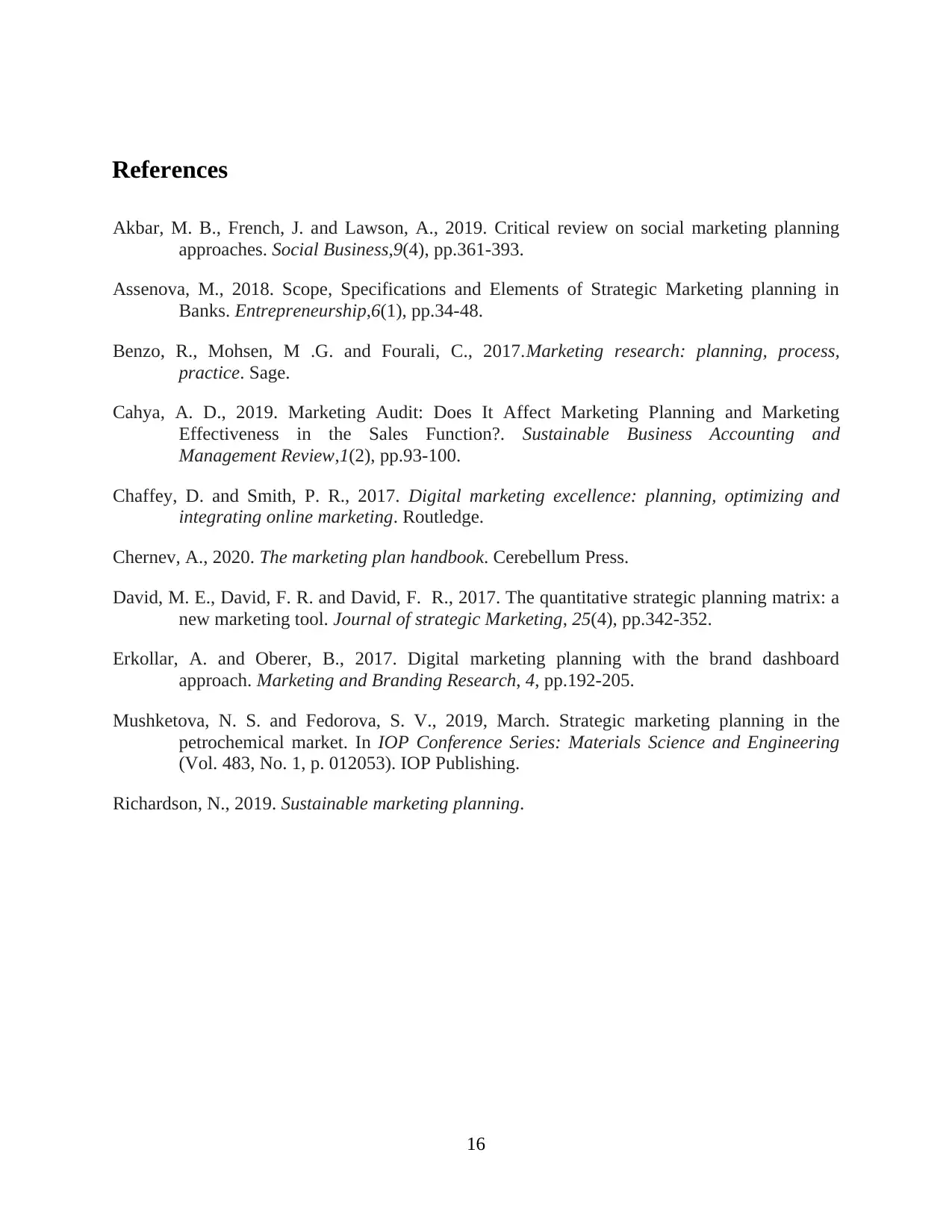
References
Akbar, M. B., French, J. and Lawson, A., 2019. Critical review on social marketing planning
approaches. Social Business,9(4), pp.361-393.
Assenova, M., 2018. Scope, Specifications and Elements of Strategic Marketing planning in
Banks. Entrepreneurship,6(1), pp.34-48.
Benzo, R., Mohsen, M .G. and Fourali, C., 2017.Marketing research: planning, process,
practice. Sage.
Cahya, A. D., 2019. Marketing Audit: Does It Affect Marketing Planning and Marketing
Effectiveness in the Sales Function?. Sustainable Business Accounting and
Management Review,1(2), pp.93-100.
Chaffey, D. and Smith, P. R., 2017. Digital marketing excellence: planning, optimizing and
integrating online marketing. Routledge.
Chernev, A., 2020. The marketing plan handbook. Cerebellum Press.
David, M. E., David, F. R. and David, F. R., 2017. The quantitative strategic planning matrix: a
new marketing tool. Journal of strategic Marketing, 25(4), pp.342-352.
Erkollar, A. and Oberer, B., 2017. Digital marketing planning with the brand dashboard
approach. Marketing and Branding Research, 4, pp.192-205.
Mushketova, N. S. and Fedorova, S. V., 2019, March. Strategic marketing planning in the
petrochemical market. In IOP Conference Series: Materials Science and Engineering
(Vol. 483, No. 1, p. 012053). IOP Publishing.
Richardson, N., 2019. Sustainable marketing planning.
16
Akbar, M. B., French, J. and Lawson, A., 2019. Critical review on social marketing planning
approaches. Social Business,9(4), pp.361-393.
Assenova, M., 2018. Scope, Specifications and Elements of Strategic Marketing planning in
Banks. Entrepreneurship,6(1), pp.34-48.
Benzo, R., Mohsen, M .G. and Fourali, C., 2017.Marketing research: planning, process,
practice. Sage.
Cahya, A. D., 2019. Marketing Audit: Does It Affect Marketing Planning and Marketing
Effectiveness in the Sales Function?. Sustainable Business Accounting and
Management Review,1(2), pp.93-100.
Chaffey, D. and Smith, P. R., 2017. Digital marketing excellence: planning, optimizing and
integrating online marketing. Routledge.
Chernev, A., 2020. The marketing plan handbook. Cerebellum Press.
David, M. E., David, F. R. and David, F. R., 2017. The quantitative strategic planning matrix: a
new marketing tool. Journal of strategic Marketing, 25(4), pp.342-352.
Erkollar, A. and Oberer, B., 2017. Digital marketing planning with the brand dashboard
approach. Marketing and Branding Research, 4, pp.192-205.
Mushketova, N. S. and Fedorova, S. V., 2019, March. Strategic marketing planning in the
petrochemical market. In IOP Conference Series: Materials Science and Engineering
(Vol. 483, No. 1, p. 012053). IOP Publishing.
Richardson, N., 2019. Sustainable marketing planning.
16
1 out of 19
Related Documents
Your All-in-One AI-Powered Toolkit for Academic Success.
+13062052269
info@desklib.com
Available 24*7 on WhatsApp / Email
![[object Object]](/_next/static/media/star-bottom.7253800d.svg)
Unlock your academic potential
© 2024 | Zucol Services PVT LTD | All rights reserved.


